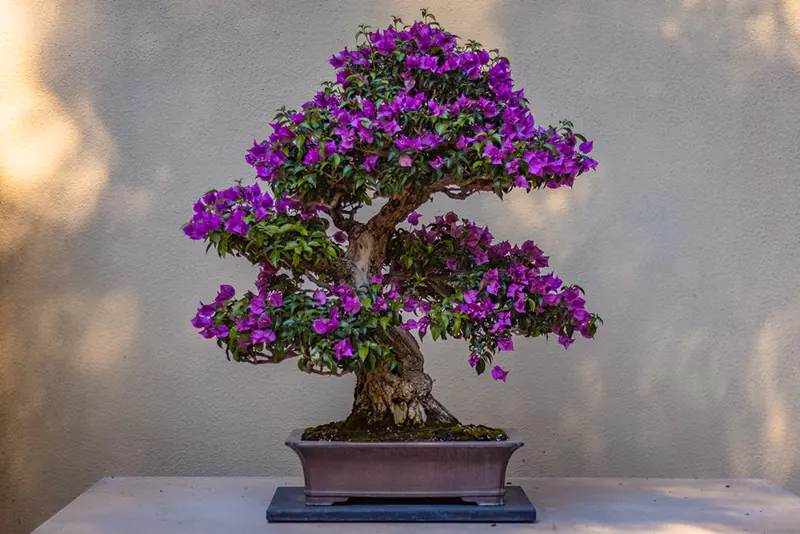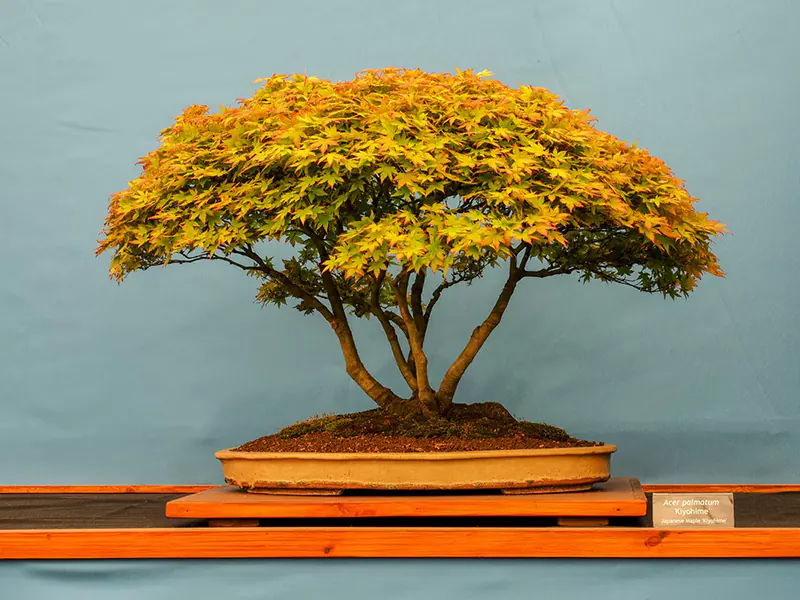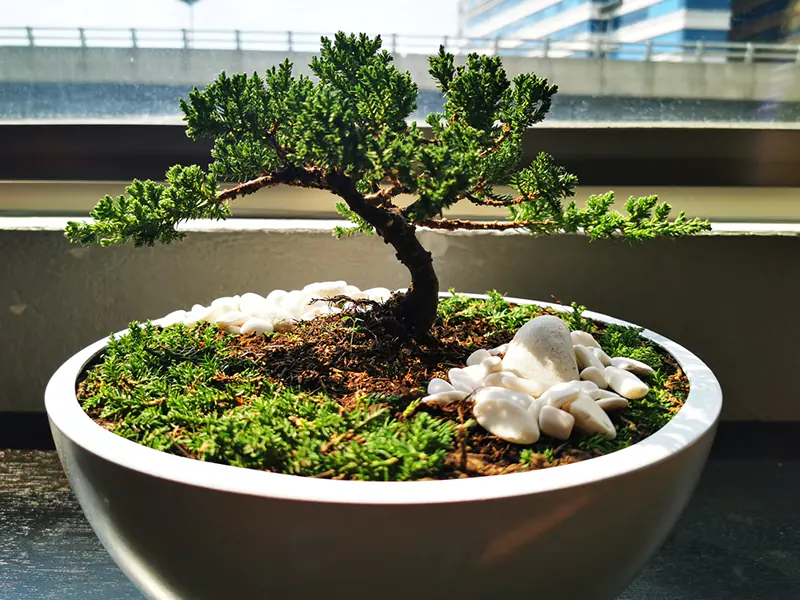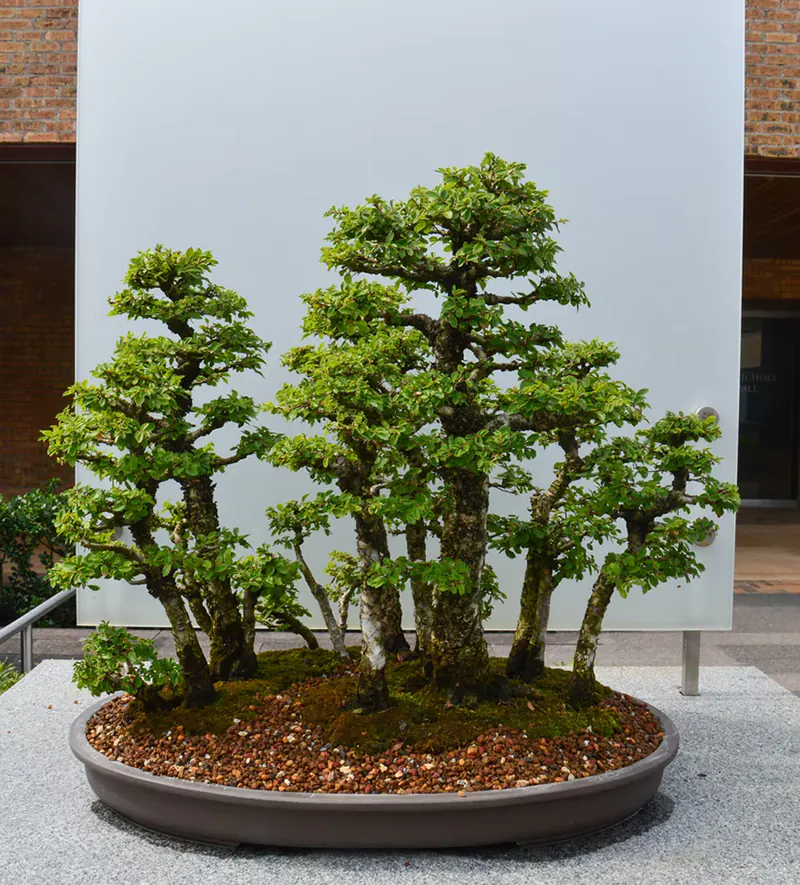How To Care For A Bonsai Tree Inside in 5 Easy Steps
One of the common questions we receive from our followers is how to care for a bonsai tree inside. There are so many environments in which you can keep them, but not all of them are suitable. That’s why it’s essential that you do your research for the specific species you have.
In this guide, we’ll first show you how to care for an inside bonsai so you can get the basic idea. We want you to read further, though, as you’ll need to know if the trees are compatible with all indoor environments. We’ll end by discussing where you can place it in your home or office.

Can you Grow a Bonsai Inside?
Let’s form the basis of where the question comes from. You see, trees grow outside in the wild, so the natural conclusion is that bonsais follow the same habits. However, you need to remember that the tiny trees are in containers and not in the ground, so the same rules don’t apply.
Most species love direct sunlight and being outdoor bonsai trees. Some prefer only a few hours of sunlight with dappled shade for the rest of the day. You also find bonsai species that don’t mind being inside a house or office as long as there’s direct light in some form.
Finally, you have low-light bonsais that actually thrive with as little light as possible. The sunlight burns the leaves and causes damage, which is why they prefer being inside. We’ve already made a list of the best indoor bonsais to buy online, so we won’t repeat it in this article. Here’s a quickly list, though:
- Snow Rose
- Dwarf Umbrella
- Chinese Elm
- Fukien Tea
- Pomegranate

How To Care For A Bonsai Tree Inside
We have a detailed bonsai tree care guide that covers most of the generic details. We recommend you check that out if you’re uncertain about a few aspects.
In terms of how to care for a bonsai tree inside, here are the steps you’ll need to take to ensure they thrive in the environment.
Step 1: Evaluate the Location
As we’ve mentioned already, indoor bonsais need plenty of sunlight so they can perform photosynthesis and form chlorophyll. The best time is in the early hours of the morning so that they have the energy they need for the rest of the day to produce new stems. If you only have indirect sunlight, it’s ok if you have a window that faces the sun in the north or south for the afternoon through to the evening.
Of course, we need to consider those working in an office environment. If you’re lucky enough, you can place small bonsai trees on the windowsill inside the room. Putting it on your desk is also alright if the sunlight manages to reach the leaves during the day.
Now, to cover the issue with artificial lights. Those bulbs you have in your office don’t count as a replacement for sunlight. There are no UV rays that the trees need. Be sure to have only natural sunlight streaming in from the outside, or consider purchasing a bonsai grow light that performs a similar function.
Step 2: Air Conditioning, Flow, and Circulation
Bonsais need a healthy dose of fresh air to survive. They perform gaseous exchange via the leaves, exchanging our spent carbon dioxide for oxygen that it releases into the air. Basically, it needs the carbon element in the air, pushing back the clean oxygen.
There are many aspects you need to consider when considering how to care for a bonsai tree inside. The first is that you shouldn’t place it near an open window. While it will love the fresh air, it won’t appreciate the constant breeze on the foliage. Being outside in the open air is one thing; having the wind blow on the leaves from one direction constantly is another. It will damage the leaves.
Another element is air circulation. Sometimes, the indoor environment can become stuffy if there’s no proper ventilation. If you have bonsais with thick foliage, they’ll struggle to cope. Also, you should prune some branches and leaves so that the air can move between them.
Most indoor environments have air conditioners to cool the rooms during hot summers. The problem with ACs is that they usually dry out the air, leading to lower humidity. As you’ll see in the next step, the bonsai trees need plenty of moisture in the air, so it will help if the AC is also a humidifier.
Step 3: Measure the Humidity
Let’s continue discussing the air when caring for bonsai trees inside, but from a different perspective. There needs to be relatively high humidity, more than 65%, for bonsais to really enjoy indoor environments. In many cases, it may be challenging to meet this requirement.
There are two factors at play here. The first is increasing the air moisture where necessary. You can either use a humidifier, spray with a bottle, or place a bonsai humidity tray under the pot. Of all these options, the last one is the best choice for most indoor areas.
The second factor is watching out for mold and other fungi. In dark, damp conditions, fungi love to grow and feed on any plants they can find. If you see powdery mildew on the leaves or stems, you need to take corrective action. This is where plenty of sunlight and air ventilation come into play the most.
Step 4: Indoor Bonsais Still Need Rest
Why is this step important? You see, the theory is that bonsai trees go through a dormant stage in winter, especially when the temperature drops and frost arrives. While deciduous trees drop their leaves, evergreen trees retain theirs. Still, they both go through a resting period so that they can recover and prepare for spring.
What does this have to do with caring for a bonsai tree inside? Well, it may be warm inside your home or office due to heaters or air conditioning. You might not see much change in the foliage, as the tree is enjoying a warm environment as if it’s still summer. That doesn’t mean that it isn’t resting for the next spring.
What we mean is that you need to stop feeding your bonsai tree fertilizer. Also, it doesn’t need as much water as before unless there’s so much heat in the room. You should check the soil with your finger to see how dry it is before giving any more water. It will still remain thirsty during this time.
Step 5: Please Don’t Touch
Have you seen what visitors due the first time they see your bonsai tree, especially in the office? They walk up to it, touch it, and say, “Oh my goodness, this is beautiful!” Don’t get us wrong; the small tree loves the attention, as it feeds off the energy and waves emanating from them while they speak.
The problem is when too many people touch the leaves during the day. If you’ve ever walked into a corporate building with palm trees in massive pots, you’ll notice that some of the leaves are yellow or brown. That’s due to humans brushing against them as they walk past to meetings or leaving the area.
The same happens with some bonsai species, especially conifers. When too many people touch the needles or leaves, they eventually start turning brown from the constant interaction. If you find this to be the case in your environment, you can place a small sign by the pot stating “Please Don’t Touch”.
We’ve actually seen these signs at bonsai nurseries where we buy our trees. It’s usually by the older, mature bonsais that are at a fragile stage of their lives. While feeling the leaves and structure, it’s so easy to accidentally break some stems. And then all you hear is “I’m sorry.”
Pros and Cons of Growing a Bonsai Indoors
There are plenty of benefits to keeping your bonsai tree inside your home or office, scientifically and spiritually. On the other hand, there are also disadvantages you should be aware of. Here’s a quick summary of the pros and cons.
Pros
- Decreases human ailments like colds and sores due to keeping a healthy environment for your bonsai
- Lowers stress levels
- Increases productivity and focus
- Reduces VOCs and other air pollutants
- Increases oxygen levels
- Creates a sacred connection between you and nature
- Devotion to tree builds patience
- Seasonal changes relate to endings and new beginnings
- Taking care of your bonsai tree inside reminds you to care for yourself
- Easier to protect the bonsai from adverse conditions outside
Cons
- Introduces pests and diseases inside if not maintained properly
- Toxic spores on leaves can lead to health conditions for you and our bonsai
- Not compatible with all indoor environments
- Flowering bonsais with pollen may affect allergic reactions or asthmatic conditions

Different Indoor Environments
So we’ve covered the basics of how to care for a bonsai tree inside. You understand the main principles, and you’re ready to go. Yet, your bonsai isn’t doing too well, and you don’t understand. What went wrong?
The issue is that not all indoor environments are the same. Each one has a few aspects you need to consider before bringing your bonsai indoors. We’ll share some of our experiences with you so you can see what we mean.
Residential Homes
The most common placement for bonsai trees inside is within residential homes. Homeowners love trees in their gardens and potted plants in their houses. Of course, the best location is outside in the yard, but not everyone has that luxury, especially when the house takes over most of the property.
Pets are a major concern for homeowners with bonsais. If you place them outside, you have cats, dogs, mice, birds, and other animals to contend with. Adverse conditions, such as bad weather, are other problems. It’s much easier to care for a bonsai tree inside in these conditions.
The beauty of a residential house is that you usually have various indoor environments ideal for the bonsai. Here’s a quick look at them and what you should note:
- Living room: Probably the best spot to place bonsai trees inside, as you’ll see it there the most, and there’s sufficient space and light
- Dining room: The bonsai takes the spotlight as a centerpiece on the table.
- Kitchen: You can use the counter to place the bonsai, as it will love the humidity from the steam produced while cooking. Just keep your tree away from the heat.
- Bathroom: The steam from the bath will also help with humidity levels, but is there enough sunlight in your bathroom?
- Bedroom: This room is our favorite spot for bonsais, as we get to see them when we awaken and go to sleep. It will help with breathing during the night thanks to the fresh oxygen supply and reduced air pollutants.
- Porch: Our porch at home is where we keep most of our bonsais. The windows face the north and west, which means it receives indirect sunlight during the hot afternoon and direct sunlight in the evening. For the bonsais that prefer direct sunlight in the morning, we have a special patio outside.
Apartments
Many people aren’t fortunate enough to have a residential home. Or perhaps they feel they’re better off in an apartment. Either way, you can still keep bonsai trees in your flat. The same conditions apply as mentioned above for home but to a lesser degree.
However, you may be lucky enough to have a balcony or small garden attached to your apartment. These locations are ideal for bonsai trees that love to be outside in the sun. Still, there’s no reason you can’t keep it inside your wonderful home where there’s bright light and plenty of love.
Industrial Environments
When we say industrial environments, we’re referring to factory and machinery-type facilities. In most situations, these buildings have plenty of dust and other pollutants that are only cleared away at the end of the day. Humans usually wear masks and other protective gear to prevent the items from entering the body.
Bonsai trees aren’t so lucky. We mentioned before that they help with VOCs and pollutants, but they’ll suffocate if the leaves are smothered with them. You should also not have bonsai trees inside industrial environments that produce excess heat.
Commercial Stores
Retail stores usually only focus on the products they’re selling, which can also include bonsai trees. If not, you can also keep the tiny trees in the shop on counters to attract customers or to make you smile when you look at them now and again. They also brighten the store with their energy.
You have three chief concerns with caring for a bonsai tree in your store. Obviously, there isn’t much, if any, natural sunlight. Secondly, you’ll have so many customers wanting to touch it. The biggest issue is when there’s central air conditioning throughout a shopping center and mall and you can’t control the temperature or humidity.
Government Facilities
I used to work for my local government for 15 years before I left to make writing my full-time career. The one aspect I really disliked about it is that plants and bonsai trees don’t do too well in these environments. The central air conditioning and lack of natural light were only two of the issues I encountered.
The other issue that irked me more was that the government can never make up its mind about where employees should be placed. They’ll move you to one facility for a few years until they become bored or suddenly have a new “corporate strategy” for office accommodation. As much as I hated relocating office every two years or so, I’m sure my plants hated it more. They don’t like changing conditions. Now I know why I get along with the small trees so well.
Other Types of Indoor Environments
We’ve tried to cover as many of the main indoor environments, but we’re sure we may have missed some. Government facilities are similar to administrative buildings. If you live on a boat, we’re sure you can apply the apartment rules. If you have a unique situation that doesn’t fit into any of the above categories, be sure to let us know.

Final Thoughts
There you go. We’ve completed our detailed guide on how to care for a bonsai tree inside. As you can see, we’ve tried to cover as many tips as we could, while keeping in mind that there are different environments. We didn’t want to be like so many other bonsai sites that just gave generic guides and left you stranded.
If you have any questions on anything we may have missed, please let us know in the comments.







